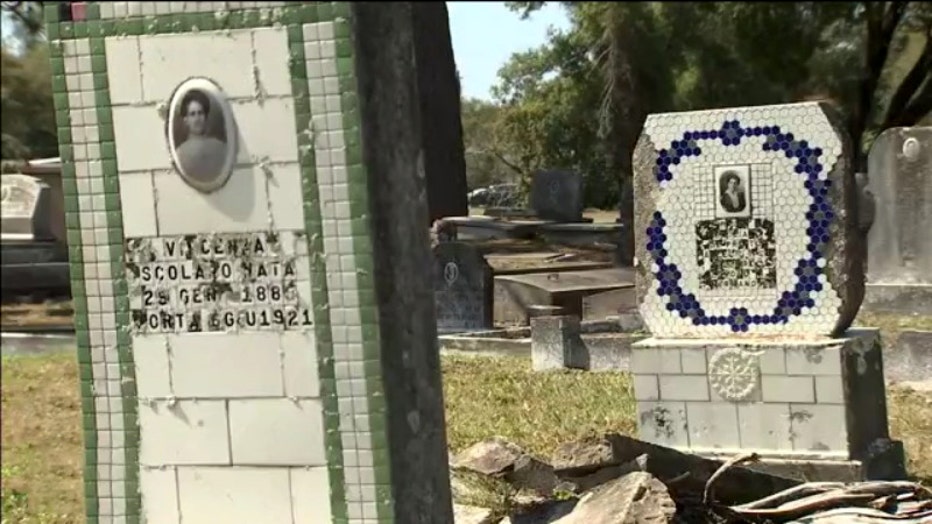Fight to save part of Woodlawn Cemetery goes before Tampa leaders
TAMPA, Fla. - At a time when forensic researchers are working to uncover dozens of lost cemeteries and graves in the Tampa Bay area, one local cemetery owner is asking city leaders to rezone a portion of their cemetery in order to pave the way for homes for the living.
On Thursday, Tampa City Council will consider a request to rezone a 1.56-acre parcel within the historic Woodlawn Cemetery.
The parcel is located in the northwest portion of the 40-acre cemetery. The land was sold to the Greater Tampa Showmen’s Association in 1971 and became known as Showmen’s Rest Cemetery.
Although classified as a cemetery on the Hillsborough County property appraiser’s website, Showmen’s Rest, Inc. says the grounds they’re asking to be rezoned were never used for burials.

Last fall a developer working in conjunction with Showmen’s Rest Inc. hired a company to conduct its own ground penetrating radar (GPR) survey of the area. The company, GeoView, said its tests did not find evidence of graves.
PREVIOUS: Woman fights to keep cemetery for circus, carnival workers from being turned into townhomes
Historians and forensic researchers, however, say those tests didn’t go deep enough.
"I would think for the city to change a designation like that they’re going to have to do really extensive fieldwork because GPR alone doesn’t tell us everything that we need to know," says USF forensic anthropologist Dr. Erin Kimmerle.
Kimmerle has been at the forefront of the search for lost graves and cemeteries in the Tampa Bay Area. Last week she presented the findings of a two-year study that helped track down 45 lost cemeteries in Hillsborough County. She's also helped identify cemeteries now buried under stadiums, schools, roads, and housing complexes.
"Sadly, what you see happen all the time is that cemeteries get built over, especially in places that are unmarked, because developers look around the landscape and say, 'there’s nothing here'," says Kimmerle.
Woodlawn Cemetery dates back to 1888. Over the years it was divided into six cemeteries on one footprint. As Kimmerle explains, many boundaries and grave sites have shifted and become lost over the years.
Previous coverage: Push to save Woodlawn Cemetery from development
A developer wants to rezone the old Woodlawn Cemetery, but the community is pushing back.
"A lot of existing cemeteries, such as Woodlawn, already have boundary issues. If you look back at the early history of Woodlawn, the first probably 20 or 30 or so years undertakers didn’t really follow the maps and so they would constantly have problems where graves would be in the alleyways or the roadways of the cemeteries. They were haphazard," says Kimmerle.
While acres of headstones in Woodlawn bare the names, and in many cases faces, of neighbors who once called Tampa home, historic records indicate there are many more people who lie in graves that are no longer marked.
Kimmerle says records show Woodlawn was used to bury thousands of people whose graves are no longer, or perhaps never were, marked with headstones. They include African Americans, who would have been buried in sections marked "colored" during segregation
"It had its own separate fence and entrance and that was in, there's reference to the northwest corner," explains Kimmerle.
It's unclear if the northwest corner referred to in records aligns with the boundaries of Showmen's Rest, located in the present northwest corner of the cemetery. Kimmerle says either way, it’s likely the entire cemetery would have been used for burials.
"When it comes to boundaries, cemeteries are usually larger than we think, not smaller," says Kimmerle. "Many times graves are not marked and that needs to be the assumption rather than thinking that that’s an exception."
Kimmerle says other lost graves include those for children, women and the elderly living in group homes, unclaimed people who died within the city and those who could not afford to purchase their own plot and headstone.
"All of those different groups of people would’ve had their own sections at one point," says Kimmerle.
In 2005 the city’s Parks and Recreation Department commissioned a GPR survey for an entire section of the cemetery known as Potters Field, which was used as burial grounds for the city’s poor. The survey showed nearly 600 suspected graves in what is now an empty field running along North Boulevard and framing the boundaries of Showmen’s Rest.
"That [survey] map shows yellow dots of possible burials that line the property line there. It’s a cemetery," said Aileen Henderson, who a started a Facebook group called Save Woodlawn Cemetery.
Henderson knows just how confusing the old cemetery’s records, and lack thereof, can be. In her work researching Woodlawn, she discovered her own great grandparents graves had been relocated within the cemetery.
Unlike her family’s graves, she believes hundreds, if not thousands, are unmarked. That's why she’s fighting to block any attempt to rezone the cemetery as residential.
"You bought a cemetery and there’s responsibility that comes with that. You can’t just decide to change the land use because you want to," says Henderson. "The bottom line is it’s a cemetery. You don’t build on sacred ground."
Kimmerle worries a decision to rezone part of the historic cemetery could have further repercussions.
"If you start parceling out little avenues and pieces of existing cemeteries for development what does that mean for other cemeteries, especially for the ones that aren’t even marked?" says Kimmerle. "Most states protect cemeteries. They don’t allow such changes and I think that is something that Florida in general has been struggling with in seeing all these unmarked burial grounds coming to light. I think this would have a very broad implication."

